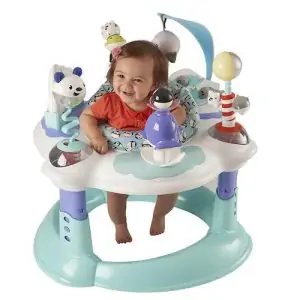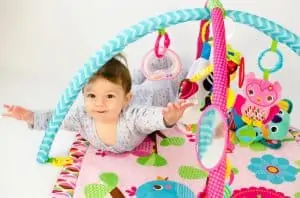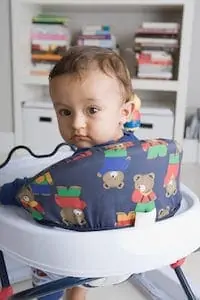When you buy an exersaucer, you need to look at all the different types of baby activity centers. All are designed to encourage your baby to play and have sensory experiences and come equipped with different materials, textures, colors, and patterns.
Just because they all have similar goals does not mean they’re all the same. So, let’s look at the different types of exersaucers to help make your decision.
The 6 Types of Baby Activity Centers
Play Mats
Playmats can be used from birth. They’re typically comfortable mats with an arch over the top that has dangling toys. The toys are colorful and designed to encourage your child to play.
This type of baby activity center can be used as soon as you bring your baby home from the hospital, but don’t expect your child to play at first. In the beginning, they’re a safe place to put your child with colors, lights, and music to attract his attention.
You can use these mats for tummy time, and they help to encourage your baby to roll over as well.
Jumping Centers
If you think about an exersaucer, a jumping activity center is what you might imagine. They’re designed to let your child jump. Durable bands hang some, and your child jumps on the floor with his feet. Others have a platform underneath.
Either way, these are meant for active babies who love to be moving. Your child will love to bounce and jump for hours. Most baby centers also have toys and music to keep your child entertained, even when they don’t want to jump.
Stationary
Not all activity centers are meant for jumping. Stationary activity centers are seated in activity centers. You put your child into the seat, which typically spins, and he can play with the toys around him.
Typically, stationary centers can be used before jumping ones because babies don’t develop the necessary leg muscles until 6-7 months or later. You don’t want to put unnecessary stress on your baby’s legs and potentially cause issues with development.
Stationary centers are a good compromise. Babies can sit in the seat and play with the toys without putting any stress on their legs.
Portable
If you’re looking for a center to take you to and from family members’ homes, you’ll need a portable center. They either fold or come apart quickly.
Most portable centers have fewer things for your child to do, but they’re designed to be easy to take places with you. Whether you’re going on vacation or like to visit family often, the portable is the way to go. Also, they’re much easier to store. So, if you have a small apart or home, a portable activity center can be stored away when not in use.
Portable activity centers typically have folding legs, a swivel seat, elastic in the seat to let your baby bounce, and a multi-stage tabletop with plenty of accessories.
Sit-to-Stand Activity Tables
Another option is to get your baby an activity table. You can start to use these when your baby sits independently. The legs come off the table, and you can set them in front of your child. He will smack and play with the toys happily.
As he ages, you can put the legs back on the table, and he can use the table as support as he learns how to stand. Babies love standing at their activity table, even practicing walking around them.
Activity center tables contain colors, textures, and developmentally safe toys. You can expect the toys to make sounds and have different lights.
Activity Cubes
Last, if you’ve ever taken your baby to the doctor’s office, you’ve seen the wooden activity cubes. These are classic, and every child needs to have one. They last for years and are a fantastic investment.
These cubes have bead mazes, spin toys, sliders, and other activities. For parents who prefer a low-tech option, activity cubes are the way to go. Your baby sits in front of the cube, but recently, some companies have made similar products that let your baby stand at them.
Final Thoughts
Picking the right baby activity center for your child is an important decision. You don’t need to pick just one based on age and weight limit! Some parents want to have more than one, or you can choose the one that will fit your baby’s needs as he gets older.
Hey, this is Linda. My biggest accomplishment in life is being a mother of four children. Their current ages range from almost ten years old down to 20 months old.
I’m passionate about writing parenting articles because I understand so well all of the problems and trials you face as a parent. From breastfeeding woes to budgeting problems and behavior problems, along with everything in between, chances are I’ve faced it over the last ten years. Read more about Linda here.





